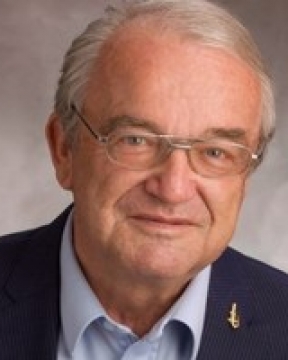 |
Hans LeuenbergerUniversity of BaselThe Organic Supercomputer Able To Replicate As Virtual Patient 2nd Intl. Symp. on Technological Innovations in Medicine for Sustainable Development Back to Plenary Lectures » |
Abstract:In 1869 Friedrich Miescher, Basel, first identified "nuclein" inside the nuclei of human white blood cells. This term was later changed to “deoxyribonucleic acid” (DNA) [1]. Erwin Schrödinger published in 1944 “What is Life?” by predicting the role of DNA [1] as genetic code [2]. Based on the work of Nobel Laureate Ilya Prigogine, Hans Leuenberger wrote “What is Life? A new Human Model of Life, Disease and Death – A Challenge for Artificial Intelligence and Bioelectric Medicine Specialists” [3] for the 40th anniversary of SWISS PHARMA. Later he presented “Virtual Patient & in-silico Design of Solid Dosage Forms”[4]. The current model of a Virtual Patient is described by 4 pillars of the Center of Pharmacometrics & Systems Pharmacology, CPSP, at the University of Florida [5] consisting of Population Pharmacokinetic and Pharmacodynamic Modeling, Real World Outcomes, Artificial Intelligence and Mechanistic Modeling. The goal of CPSP is to create a rigorous and integrative academic translational science program in quantitative clinical pharmacology with a focus on bio-simulation. The common denominator is modeling. The first two pillars are linked to many patients. Artificial Intelligence tries to mimic a human being in 4 steps, Machine Learning, Deep Learning, Theory of Mind, and Self Awareness. Mechanistic Modeling is inspired by Physiologically‐Based Pharmacokinetic Modeling and Simulations that need to be complemented by cardio-vascular and nervous wiring system etc. In other words, the holistic VIRTUAL PATIENT can be described as an organic supercomputer able to replicate, consisting of approximately 40 1012 cells as microprocessors [3, 4]. This healthy being corresponds to stage 4 of Artificial Intelligence. The computer operating system of the VIRTUAL PATIENT is, as we know, sensitive to single drugs, to a combination of drugs (HIV treatment), to the combination of Syrosigopine, and Metformin as an anti-cancer agent [6]. Thus, the combination of low dose generic drugs opens a new research avenue in drug discovery [7] avoiding preclinical trials. Since Paracelsus, University of Basel, we know that the toxicity of a substance depends on the dose. Unfortunately, the early dose of a discovered drug is usually high for showing a significant effect. Our system is sensivitive to food, such as grapefruit, which is interacting with drugs, to parasites such as worms, to bugs and to viruses, etc. If our body (computer hardware) is severely damaged by a car accident can it be rebooted as a supercomputer, respectively reanimated as human being in an emergency room? As conclusions, it is proposed 1) to systematically evaluate combinations of n drugs, with n = 2, 3...m low dose generic drugs. In an optimal case new safe therapies of n drugs showing less side effects can be registered. 2) The pharmaceutical industry should adopt the workflow of the automotive industry by first evaluating in-silico the tablet formulations before manufacturing the drug delivery systems [8]. Thus, time to market can be reduced. 3) The sensitivity of the VIRTUAL PATIENT = DIGITAL TWIN can be explored on the basis of Clinical Phase I – III studies using a combination of n low dose generic drugs [7]. |
|